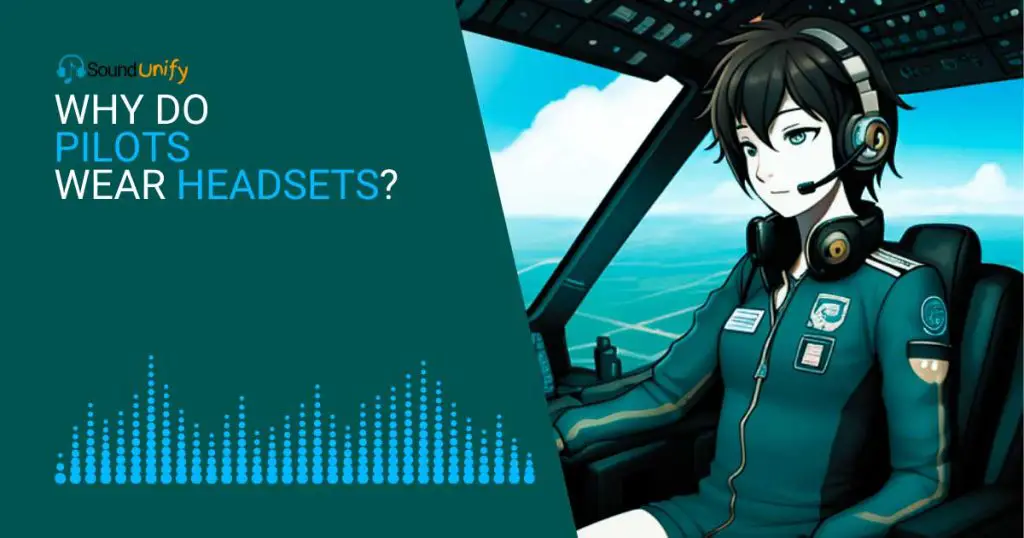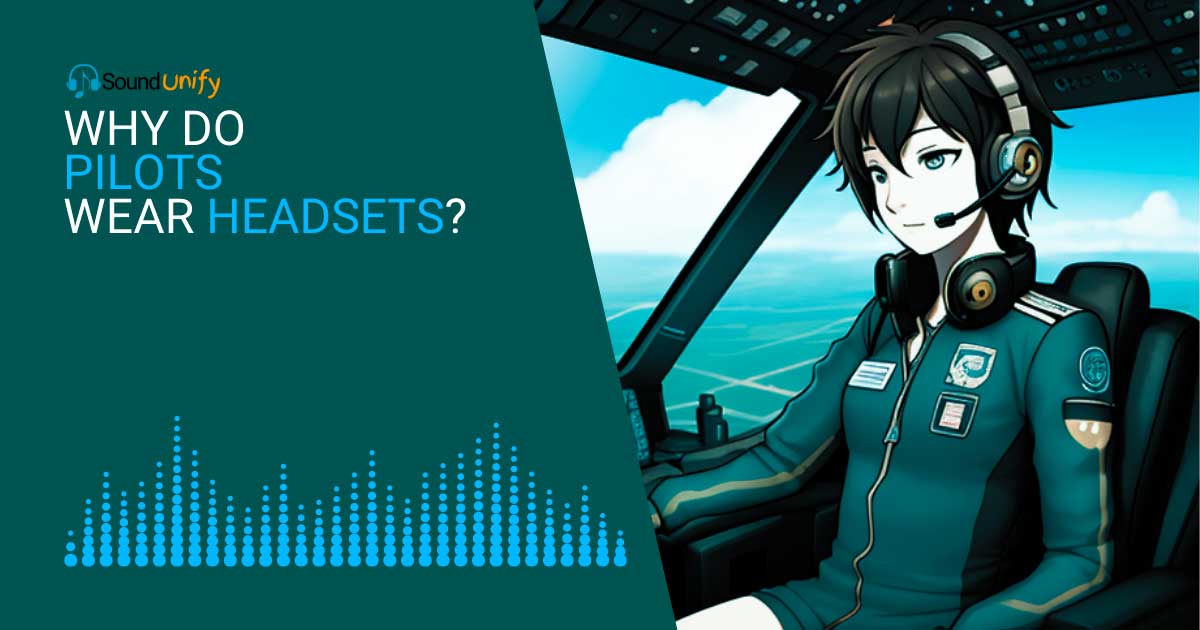Flying is an incredible experience, and the comfort and safety of pilots and passengers depend on their ability to communicate effectively during flights. That’s why many pilots wear headsets.
They provide a more comfortable way to communicate with other passengers and maintain contact with air traffic control. They also provide active noise reduction (ANR) technology to protect pilots from hearing loss.
In this article, we’ll explore why pilots wear headsets and the different types of aviation headsets available. We’ll also discuss how headset use can improve flight comfort and communication.
So if you’re looking for a better understanding of why pilots wear headsets or want to purchase one, read on!
8 Reasons Why Do Pilots Wear Headsets

Have you ever wondered why pilots wear headsets? It’s not just because they want to look cool. There are many important reasons why pilots need to have this specialized equipment.
From staying in touch with air traffic control to protecting their hearing from the loud roar of jet engines, headsets are essential tools for any pilot flying in the sky.
1. Keeping in Touch with Air Traffic Control
Pilots must constantly communicate with air traffic control (ATC) to maintain safe and efficient flights. Wearing a pilot headset allows them to do so without constantly being interrupted by outside noise or radio interference.
The headsets are designed only to allow sound from the ATC tower, allowing pilots to focus on controlling the aircraft and their attention on the instructions ATC personnel give.
Most headsets for pilots come with an integrated microphone that allows for two-way communication between the pilot and the ATC staff.
This ensures that all instructions can be heard clearly over any background noise or radio interference, which is especially important during high air traffic.
2. Improved Communication Between Pilots and Ground Crew
Pilots and ground crew must maintain effective communication during all stages of a flight. Headsets enable pilots and ground crew to communicate with one another more clearly, quickly, and efficiently.
This is especially important in emergencies where time can be the difference between life and death.
Additionally, many headsets are wireless and allow for better freedom of movement in the cockpit so that pilots can access different controls without having to unplug or move around wires.
This helps reduce distractions which is important when operating an aircraft at different altitudes or speeds.
3. Reducing Noise from Jet Engines
When it comes to reducing noise from jet engines, pilot headsets create an acoustic seal around the ears that blocks out background noise.
This ensures that the pilot can hear vital audio cues and stay aware of their surroundings while flying.
Headphones also come equipped with active noise cancellation technology that further reduces engine noises by creating sound waves that cancel out low-frequency sounds like those made by jet engines.
4. Enhancing Situational Awareness
Pilots rely on headsets to provide a precise level of situational awareness while in the air. With the help of their headsets, pilots can easily identify potential threats and react quickly to maintain safety.
The headset helps pilots remain focused and aware of all that is happening around them, such as other aircraft, terrain features, weather conditions, and airspace restrictions.
In addition, pilots can hear important audio cues from the cockpit instruments, such as engine readings, altimeter settings, speed indicators, and more.
5. Protection from Radio Frequency Interference
Protection from Radio Frequency (RF) interference is one of the most important reasons pilots wear headsets.
RF interference is caused by electronic devices such as cell phones, Wi-Fi routers, and other wireless equipment that emit signals in the same frequency range used by aircraft radios.
These signals can cause communication disruption and confusion in the cockpit. Headsets also have a specially designed ear cup that forms a seal around the ears providing extra protection against RF interference.
This helps ensure clear communication between the pilot and ATC, even in noisy environments such as near airports or busy airspace areas.
6. Enjoying Higher Quality Music and Audio Entertainment
Wearing a pilot headset can allow pilots to enjoy higher-quality music and audio entertainment.
As with any other form of audio, they were listening to music, or other audio entertainment through a headset will be greatly improved by using high-quality headphones.
This is especially true for pilots who may have to fly for long periods and need the entertainment to pass the time. Pilots can also use their headsets to listen to audiobooks and podcasts or watch movies during long flights.
The clear sound quality of these headsets makes it easy for pilots to stay focused on their work while enjoying some much-needed entertainment during downtime.
7. Monitoring Weather Conditions More Effectively
Monitoring weather conditions is a critical component of flying that pilots must be aware of to safely and efficiently navigate their aircraft.
Headsets provide a great advantage to pilots by allowing them to access more detailed weather information than ever before.
By wearing a headset, they can easily listen to live audio feeds from ground-based radar systems, giving them up-to-the-minute updates on the current weather conditions in the area they are flying in.
This allows them to make more informed decisions regarding their route and altitude selection when navigating inclement weather.
8. Ensuring Safety and Efficiency during Takeoff and Landing
Ensuring safety and efficiency during takeoff and landing is a critical responsibility of any pilot. Pilots wear headsets while in the cockpit to ensure the greatest degree of safety and effectiveness.
These headsets are equipped with noise-canceling technology, allowing them better to monitor their surroundings for potential dangers and disruptions.
Additionally, the headsets enable pilots to communicate more effectively with air traffic control, ground crew, and other personnel who may be present in the vicinity.
Pilots also use their headsets to listen closely to engine sounds, which alert them to any potential issues or malfunctions that could threaten safe flight operations.
Understanding How Headsets Work
Headsets are essential for pilots, allowing them to communicate with other aircraft and control air traffic. It’s necessary to understand how these headsets work to decide what is best for your needs.
Headsets have two parts:
- Microphone
- Headset
Both parts are connected to a single dual-plug connector, making it easy to plug into any aircraft audio system.
The microphone picks up sound from the pilot’s voice and sends it through the cable to the headset, which is changed into an electrical signal amplified and sent out over the radio frequency.
At the same time, incoming signals from other aircraft or air traffic control are picked up by the headset’s receiver, amplified, and then sent to your ears through speakers inside the headset.
Most headsets feature adjustable headbands that may customize to fit the wearer’s head and foam-filled ear cups that filter out distracting noise while allowing reasonable speech levels.
The Different Types of Aviation Headsets
There are two main types of headsets; hybrid models combine PNR and ANC technologies for maximum sound protection and communication clarity.
These headsets are ideal for pilots who fly both general aviation aircraft and commercial jets/helicopters, as they provide superior performance in any situation.
1. PNR headsets:
Aviation headsets come in various shapes, sizes, and styles to accommodate different pilots’ needs. The most common type is the passive noise reduction (PNR) headset.
These are designed to reduce outside noise by blocking sound waves with their cushioned ear cups. If you’re a general aviation pilot, an aviation headset with a passive noise reduction (PNR) is typically sufficient.
These headsets feature ear cups that cover your ears, providing effective soundproofing from the engine and wind noise.
This headset also features dynamic microphones that allow clear communication with air traffic control (ATC) and other pilots on the same frequency.
2. ANC headsets
Another type of headset is the active noise cancellation (ANC) headset. These use electronic circuitry to block out environmental noise, allowing pilots to focus on important audio cues while flying.
ANC headsets also typically include built-in microphones, allowing clear communication even in noisy environments.
If you fly commercial aircraft such as jetliners or helicopters, you’ll likely need an active noise cancellation (ANC) headset.
These headsets feature multiple microphones that detect ambient noise and generate “anti-noise” signals to cancel out background sound levels.
ANC headsets are much more effective at blocking engine and wind noise than PNR models, ensuring crystal-clear communication between ATC and other aircraft in flight.
3. Dual-earpiece design
The third type of aviation headset is the dual-earpiece design, consisting of two separate earpieces on either side of the pilot’s head.
This design helps ensure that audio cues from both sides are heard evenly, providing maximum situational awareness for pilots in the cockpit.
Features to Look for When Buying a Headset

When shopping for a headset for a pilot, it’s important to ensure that the model you buy is well-suited for aviation use. There are several features to look for when making your purchase.
- The most important factor is noise cancellation. Pilots must hear radio transmissions and other cockpit sounds clear, so headsets with advanced active noise reduction technology are highly recommended. This helps reduce background noise from the airplane engine, which can be very loud during flight. It also helps protect your hearing by allowing you to hear at a lower volume than if you were using regular headphones.
- Sound quality is also an essential factor when choosing a headset. Look for headsets featuring noise-canceling microphones designed to filter out background noise like engine and wind noise. This will help keep conversations clear and understandable even in loud environments. Also, consider headsets with active noise cancelling technology designed to reduce unwanted ambient noises like engine hum or wind by producing sound waves that cancel them out before they reach your ear.
- Consider compatibility with existing equipment in the aircraft. Most headsets will have connectors and adapters to plug into current aviation communication systems, such as intercoms or radios. Make sure you get the correct type of headset for your specific system; if you still need additional adapters or cables to make it work properly.
- Durability is also an essential factor when buying an aviation headset. The headsets must withstand extreme temperatures, vibrations, and other conditions during flight. Look for models made of durable materials that are designed specifically for pilots and other aviators—they tend to be more reliable than consumer-grade models.
- Comfort should be considered when purchasing a headset, especially if the pilot wears it for long flights. Look for models with adjustable headbands and soft earpads that fit snugly around your ears without being too tight or loose. Ensure the microphone is positioned comfortably so it won’t rub against your skin during use. Otherwise, it could become annoying after extended periods.
Popular Brands in the Aviation World
When selecting a headset for aviation use, there are several popular brands that pilots and flight crews trust.
These brands specialize in producing quality audio headsets with features like noise cancellation and advanced sound technology that are essential for communication during flights.
- The Bose A20 Aviation Headset is one of the most popular choices among pilots. It has a lightweight design, Bluetooth capability, and an impressive 45 hours of battery life. The noise-canceling microphone helps reduce background noise, allowing clear communication between the pilot, ground crew, or other aircraft. This headset offers superior comfort for long flights due to its contoured ear cushions and adjustable headband.
- Another famous brand is Lightspeed Aviation, which produces top-of-the-line headsets with superior audio clarity and comfort features like soft leather ear cushions and flexible headbands. Their Zulu 3 headset model is their flagship product, offering Active Noise Reduction (ANR) technology for better sound quality even in noisy environments and Bluetooth capability for hands-free communication.
- Finally, Sennheiser is a trusted name in high-end audio equipment, including aviation headsets explicitly designed for pilots and flight crews. They offer two models: the Momentum 2 Aviation Headset and the HD 450BT Aviation Headset, which provide superior audio clarity even in loud environments thanks to their advanced noise cancellation technology. Both models have Bluetooth capabilities, adjustable headbands, and comfortable ear cups for long flights.
Whether a professional pilot or an amateur enthusiast, selecting the right headset can make all the difference regarding safety, comfort, and performance while flying. Choosing one of these popular brands often ensures you get the best audio equipment available today.
How Headset Use Improves Comfort and Communication During Flights

5 Headset Tips to Improve Comfort and Communication on Flights
1. Choose a headset with a good fit
When choosing a headset for travel, it is important to consider the fit. A good fit means the headset is tight enough so that it doesn’t move around but loose enough so that you can hear the person on the other end of the call.
Also, ensure the microphone is close to your mouth so you can communicate quickly. Some headsets come with foam ear pads to ensure a good fit.
2. Adjust the headband and cups for a custom fit
When flying, it is essential to have a comfortable headset. One way to achieve this is by adjusting the headband and cups for a custom fit. This will ensure that the headset is not too tight or loosened and fits snugly against your head.
This will allow you to comfortably listen to music or talk on the phone while flying.
3. Settle in and speak into the microphone
The third step is to settle in and speak into the microphone. Putting on a headset can be confusing, but getting comfortable is important before you start recording.
Once you put on the headset, adjust the volume and ensure the microphone is positioned close to your lips. Speak into the microphone and wait for the green light before recording.
4. Keep a headset in your pocket for on-the-go use
Like most people, you probably use your phone while flying. But did you know that you can also use a headset to improve your comfort and communication on flights?
Headset earbuds are small enough to fit in a pocket, making them perfect for on-the-go use. Plus, headsets usually use a microphone to easily make calls without taking your hands off the controls.
5. Test your headset before your flight
Before you fly, it is essential to test your headset to ensure it works correctly. Headset manufacturers often include a set of guidelines that you can follow before your flight to ensure the device is compatible with your laptop and phone. Following these simple steps, you can use your headset without problems.
FAQ
Can pilots listen to music while flying?
In general, a pilot can listen to music while flying, depending on the specific aircraft and type of operation. In some cases, pilots may use a headset or other device to listen to music during some phases of the flight, such as during the cruise. However, any personal electronic device is typically prohibited during critical phases such as takeoff and landing. Furthermore, flying headsets can present a potential flight distraction and potentially lead to an adverse safety outcome.
Do pilots bring their headsets?
It depends on the airline’s policy. Some airlines provide their pilots with headsets, while others may require pilots to bring their own. Additionally, airline policies may require pilots to use a specific type of headset, so it’s essential to be aware of the applicable regulations and airline policy.
What’s the difference between helicopter and aircraft headsets?
Helicopter headsets differ from aircraft headsets in that they are designed to dampen the higher-pitched noise level created by rotor blades and filter out the aircraft engine’s external sound.
On the other hand, aircraft headsets are designed to reduce the low-level pitch of engine noise and the wind. Additionally, helicopter headsets are typically lighter to help alleviate fatigue from wearing the headset for lengthy periods.
Are pilot headsets comfortable?
Yes, pilot headsets generally have padded headbands and cushioned ear cups, which make them comfortable to wear. They are also designed to reduce interior noise and allow pilots to maintain crisp audio quality.
Some headsets are adjustable to suit the comfort level of the user. Specific models may include additional features such as in-line volume control and ear cup protection.
What type of aviation headsets do pilots use and why?
Pilots typically use passive headsets, noise-canceling earphones, and active noise reduction (ANR) headsets. These headsets provide effective noise reduction and block background noise so that pilots can hear their instruments and ATC instructions.
ANR headsets also feature a microphone and high-quality speakers for clear communication. They also allow pilots to better monitor air traffic and other cockpit activities. In addition, some headsets have built-in Bluetooth technology, enabling pilots to connect to compatible aircraft systems.
Conclusion
Pilots wear headsets for a variety of reasons. They provide safety, comfort, and improved communication during flights. Understanding why pilots wear headsets is essential for anyone looking to buy one.
Many different types of aviation headsets are available on the market, each with its features and benefits. Popular brands in the aviation world include Bose, David Clark, Sennheiser, and Plantronics.
When selecting an aviation headset, it’s best to look for features that allow for maximum comfort and clear communication during a flight. With the right headset from a trusted brand, pilots can enjoy a safe, comfortable and communicative experience while in the air.
James Dimento is a Chief-in-Editor of SoundUnify. He is a headphone enthusiast and creative writer passionate about audio technology. He has three years of experience writing about headphones and sound quality and is responsible for creating reviews and taking care of all administration.
